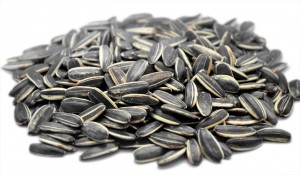Vitamin B1 (Thiamin)
 The active form of thiamine is thiamine pyrophosphate (TPP) which is essential for the conversion of pyruvate to acetyl CoA and Step 4 of the Kreb’s cycle. It is also essential for the conversion of glyceraldehyde-3-phosphate (one of the glycolysis intermediates) to ribose-3-phosphate.
The active form of thiamine is thiamine pyrophosphate (TPP) which is essential for the conversion of pyruvate to acetyl CoA and Step 4 of the Kreb’s cycle. It is also essential for the conversion of glyceraldehyde-3-phosphate (one of the glycolysis intermediates) to ribose-3-phosphate.Good sources: Sunflower seeds, liver, pork, whole and enriched grains, and dried beans. According to one source, the outer layer of seeds is high in thiamine. Thus, whole wheat breads are high in thiamine while bread made from milled grain is low in thiamine.
DRI: 0.9-1.2 mg per day
Functions: the functions of this vitamin are listed above. It also assists in nerve function.
- Cofactor to over 24 enzymes
- Essential to the production of energy from food in the form of ATP (adenosine triphosphate)
- Cofactor to pyruvate dehydrogenase (for energy production in Krebs cycle)
- Cofactor in the maintenance of myelin sheath (nerve cell insulator)
- Activates membrane ion channels which affect nerve and muscle cell function
- Cofactor to transketolase for fat, protein and carbohydrate metabolism
- Cofactor to transketolase for synthesis of ribose for incorporation into DNA (deoxyribonucleic acid)and RNA
- Cofactor to transketolase for synthesizing cellular NADPH (Nicotinamide Adenine DinucleotidePhosphate Hydrogen) used for fatty acid biosynthesis
- Cofactor to 2-oxo-glucarate dehydrogenase (also called α-ketoglutarate dehydrogenase) whichmakes acetylcholine, gamma amino butyric acid (GABA) and glutamate
- Cofactor to α-ketoglutarate dehydrogenase for mitochondrial energy production
- Cofactor to branched chain ketoacid dehydrogenase for mitochondrial energy production
- Cofactor in the hexose monophosphate shunt, an anabolic pathway used by certain cells
- Cofactor to glucose metabolism, particularly in central nervous system
- Cofactor in the mitochondrial respiratory chain
- Deficiency impairs oxidative metabolism leading to increased pyruvate and lactate, which cancause vasodilation, retention of water and contribute to heart failure (“cardiac or wet beriberi”)
- Some cardiac medication decreases vitamin B1 uptake in myocytes (muscle cell)
- Deficiency in children linked to delayed language development
- Supplementation may benefit autistics
- Supplementation may benefit inborn errors of metabolism of branched chain amino acids such as thiamin responsive branched chain ketoaciduria (also known as maple syrup urine disease)
- Regulates intracellular p53 activity (a protein that protects against tumors)
- Deficiency may cause serotonin depletion which can decrease pain threshold, decrease musclerepair enzymes (muscle soreness) and poor energy production (fatigue)
- Key role in restorative sleep
- Plays a role in acetylcholine production in the brain
- Plays a role in nerve impulse conduction
- Conversion of thiamin to biologically active form requires magnesium
- Sulfites in food destroy vitamin B1
- Excess alcohol inhibits activation of thiamine coenzymes
Deficiencies: Beri-Beri which means “I can’t, I can’t.” Infantile beri-beri symptoms include: tachycardia, vomiting, convulsions, and death. Adult beri-beri symptoms are: dry-skin, irritability, disorderly thinking, and progressive paralysis. Alcoholics are particularly at risk for thiamine deficiency for two reasons. First of all, they are likely to have a reduced intake and, secondly, alcohol decreases thiamine absorption.
Toxicity: Thiamine is not considered toxic. However, some have linked headaches and insomnia to thiamine when their doses exceeded 5 mg/d for 4-5 wks.






